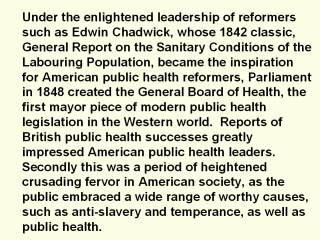 |
Thirdly, the public
health problems in American cities were becoming simply too horrible and
obvious to ignore. The 1848 Irish potato famine and the 1849 political
revolutions throughout Europe sent uncounted thousands streaming to the
United States for sanctuary. What they found were rapidly expanding cities
willing to exploit their muscles but unable or unwilling to provide adequate
housing, sewage removal, and clean water. Thousands lived in dark, dank
basements with little or no ventilation and were forced to rig boards
attached to the ceilings when their cellars flooded from heavy rains and
inadequate or non-existent city drainage to keep from drowning.
The final factor for renewed interest in organized public health was the
emergence of an organized American medical profession. Although Edward
Jarvis' 1845 view of the typical American physician was correct. The AMA,
one year after its founding in 1847, created a Committee on Hygiene in 1848
to study and report on the status of America’s public health. |
